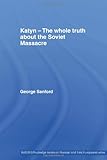
Average Reviews:

(More customer reviews)Sanford presents a wealth of information on the events leading up to and including the Katyn massacre and the decades-long coverup (in both Communist and western nations) of Soviet responsibility. Ironically, many past Soviet dissidents had acknowledged Soviet guilt for this crime (p. 213). Interestingly, evidence from Luftwaffe photos has recently become public that adds to the proof that the burials, and hence the massacre, must have predated the German invasion of the USSR (pp. 145-146).
Some 98.1% of the victims were ethnic Poles (p. 54). However, the "Poles" may include around 900 heavily-Polonized or secularized individuals of Jewish origin. Physical evidence recovered in the 1990s exhumations confirms the fact that a significant fraction of Polish victims fought back against their murderers (p. 108). Katyn was no emotional spur-of-the-moment murder. Instead, it resembled the acts of the Nazis: "The Soviet 1940 massacre, though, shares one fundamental feature with the trainloads of Jewish and Roma victims brought to be exterminated in Auschwitz and other death camps on industrial lines in batches according to a carefully thought out and scientifically organized method. The element of planned, impersonal and unemotional control predominated even though the chosen Soviet method of execution was about as direct and personal a relationship between executioner and victim as one could get." (p. 95). Sanford doesn't mention the fact that nearly 2 million of the 5-6 million murdered Jews also died through the "personal" means of being shot (by Einsatzgruppen, other German units, and their Ukrainian and Baltic collaborators).
Sanford quotes Neil Ascherson, who called Katyn "an act of selective genocide against a part of Poland's national elite, closely parallel to Hitler's order to exterminate the Polish intellectual class". (p. 83). Sanford himself concludes that: "It also suggests that the massacre was not aimed primarily to eliminate Poland's officer corps, so much as to weaken its general leadership elite." (p. 52). Finally, Louis FitzGibbon called Katyn: "The worst single unpunished crime in history." (p. vii).
Consider the progressive betrayal of Poland by the British and Americans, culminating at Teheran and Yalta. Unlike those who rationalize this event, Sanford acknowledges the fact that there was no danger of a Soviet-Nazi separate peace (p. 163), and that the Soviet puppet state was not a foregone conclusion given Red Army successes: "On the other hand, Western failure to tie Stalin down over the political future of Eastern Europe during his period of military weakness meant that Roosevelt had no cards left to play at the end-of-war conferences apart from a simple-minded banking on Stalin's goodwill." (p. 168)
Click Here to see more reviews about: Katyn and the Soviet Massacre of 1940: Truth, Justice and Memory (BASEES/Routledge Series on Russian and East European Studies)
The Soviet massacre of Polish prisoners of war at Katyn and in other camps in 1940 was one of the most notorious incidents of the Second World War. The truth about the massacres was long suppressed, both by the Soviet Union, and also by the United States and Britain who wished to hold together their wartime alliance with the Soviet Union. This informativebook examines the details of this often overlooked event, shedding light on what took place especially in relation to the massacres at locations other than Katyn itself. It discusses how the truth about the killings was hidden, how it gradually came to light and why the memory of the massacres has long affected Polish-Russian relations.

No comments:
Post a Comment